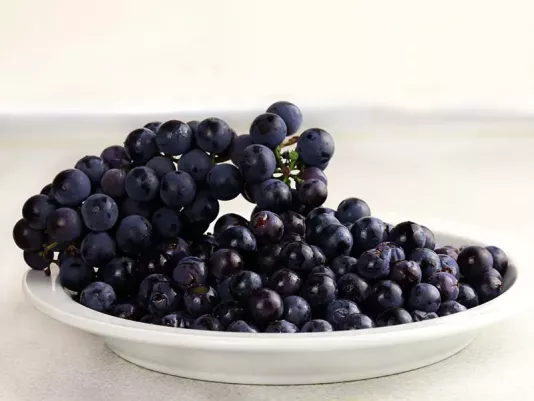Grape Liqueur
Grape liqueur – this liqueur is made from the common Isabella grape variety.

Isabella Grapes are a variety I have known since childhood and continue to work with as an experienced cook. Its berries have a deep purple color, pronounced aroma, and juicy flesh that is hard to confuse with other grapes. In my experience, it is excellent not only for table use but also for making homemade drinks and preserves. I know its skin is rather firm, but that very skin preserves the bright aroma and prevents drying out. Isabella’s taste has a distinct sweet base with a light tartness that refreshes wonderfully. I have often found that this grape shines both in sweet dishes and paired with meat or cheese platters. For me, it is a symbol of the garden’s generosity, always bringing rich harvests and new culinary ideas.
In my practice, I always begin with a careful inspection of the clusters. Ripe Isabella grapes have an even dark-purple or deep-purple color with a light waxy bloom that protects them from drying. I always check the integrity of the skin: it should be firm, without cracks or spots. If a berry is too soft, it means it is overripe and will spoil quickly. I also pay attention to the stem: if it is green and firm, it signals freshness, while a dry or brown stem points to an older harvest. I never buy clusters with damaged or moldy berries, because even one can spoil the taste of the entire bunch. Over the years, I have found that for fresh consumption, medium-ripe berries are best, while for juice or wine, the ripest berries are preferable since their flavor and aroma unfold more fully.
Before use, I always wash Isabella thoroughly under running water, as its skin is coated with a natural bloom that can hold dust. I separate the berries from the clusters right before cooking, so they stay as juicy as possible. When making desserts or sauces, I often remove the seeds, since they add a slight bitterness. To do this, the berries can be cut in half and the seeds carefully removed. However, when making juice or jam, I skip this step because the heat treatment softens the bitterness. I also use grapes in frozen form: after washing, I dry them carefully, spread them on a tray, freeze them, and then transfer them into containers. This way, I have a fragrant product even in winter. In my experience, proper preparation ensures a clean taste and pleasant texture in any dish.
I have experimented a lot with Isabella grapes and realized that temperature determines their final flavor. For juices, I always heat the berries gradually, avoiding rapid boiling. At around 85°C (185°F), the juice retains its aroma and deep color. For jams or preserves, I bring the mixture to a boil but cook it in short cycles of 5-7 minutes, allowing it to cool in between: this way the texture is preserved, and no extra caramelized notes appear. When I roast grapes with meat or cheese, I use medium heat so the berries caramelize without losing their shape. In my experience, freezing grapes for later use in sauces works well: slow thawing at room temperature preserves their juiciness. For me, temperature control is the key to preserving the natural flavor and aroma of Isabella.
In my experience, Isabella grapes pair well with both sweet and savory ingredients. I often use them in desserts with nuts, honey, or yogurt: the berries’ sweetness and light tartness create a balance. In savory dishes, I combine grapes with cheese, especially soft or aged varieties, which highlight their aromatic profile. Isabella also goes well with poultry and pork: the juicy berries bring tenderness and freshness to the meat. For sauces, I combine grapes with ginger or cinnamon, which make the flavor warmer and more layered. I have found that this grape variety always adds expressiveness to dishes, whether it’s a simple salad or a refined appetizer. The main thing is not to overload it with overly strong spices, so its natural harmony is not lost.
Over the years, I have seen many mistakes in handling Isabella grapes. The most common one is choosing overripe grapes: the berries become too soft, lose shape, and spoil quickly. I always emphasize that for desserts and fresh eating, it’s best to choose firm berries, while fully ripe ones are better suited for jam or wine. Another common mistake is improper washing: berries are soaked in water and left there, which makes them crack quickly. In my experience, the best method is to wash them under running water and dry them immediately. Storage is also often underestimated: if grapes are kept in a sealed bag, they “suffocate” and begin to mold. I always store clusters in the refrigerator in an open container or on a tray with a paper towel. It is also important to avoid overheating during cooking: rapid boiling or baking at high temperatures ruins their aromatic profile. In my practice, it is attention to these details that preserves the true taste and quality of Isabella grapes.